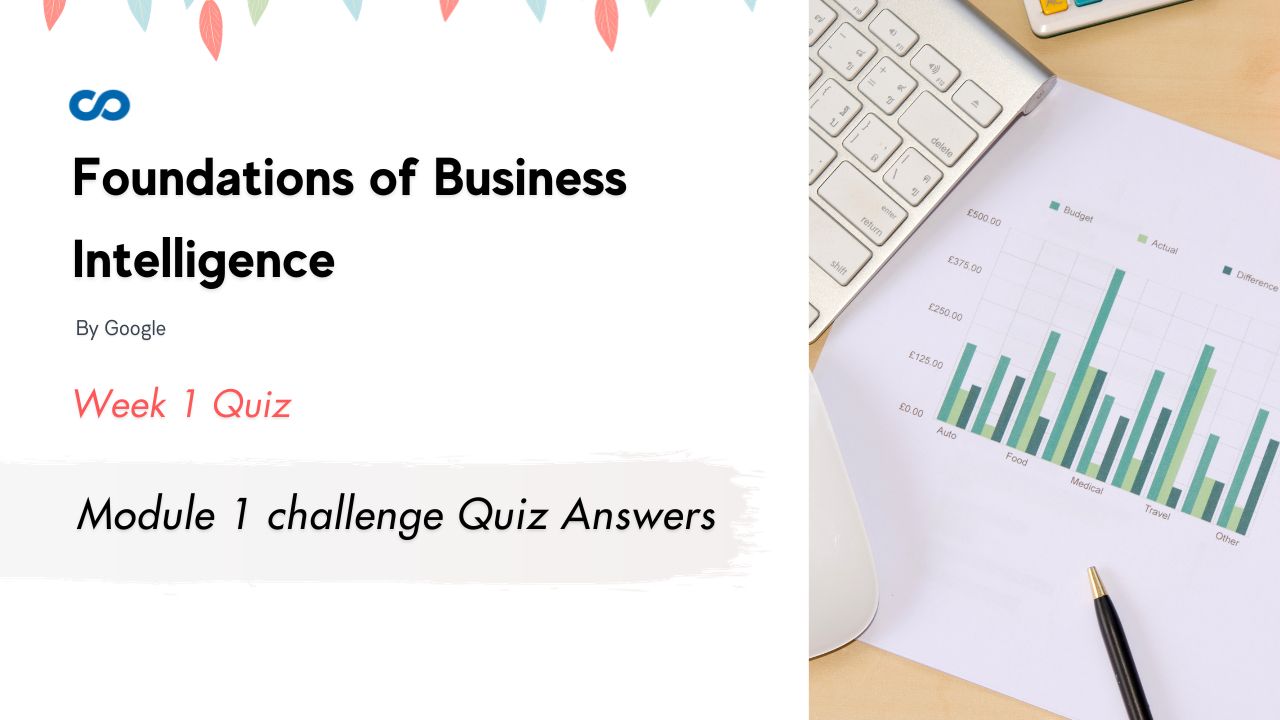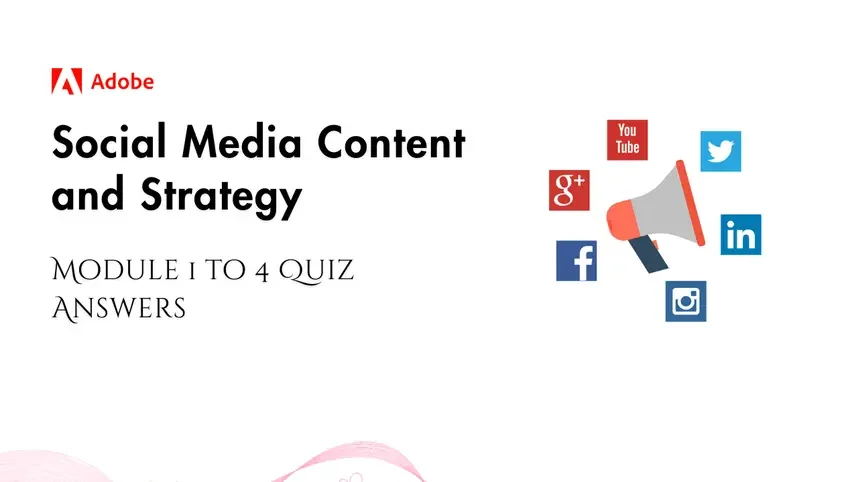Foundations of Business Intelligence Module 1 challenge Quiz Answers
In this article i am gine to share Foundations of Business Intelligence Module 1 challenge Quiz Answers with you..
Enrol Link: Foundations of Business Intelligence
Foundations of Business Intelligence Module 1 challenge Quiz Answers
Module 1 challenge Quiz Answers
Question 1)
A business analyst automates processes and information channels in order to transform data into actionable insights. Then, they share these insights with decision-makers. What concept does this scenario describe?
- Business metrics
- Business intelligence
- Business strategy
- Business monitoring
Question 2)
Which of the following statements correctly describes the roles of business intelligence engineers versus business intelligence analysts?
- Engineers apply their knowledge of large datasets; analysts are responsible for less complex types of intelligence.
- Engineers create data visualizations, dashboards, and reports; analysts present their findings to team members.
- Engineers design, configure, implement, and improve tools; analysts use those tools to retrieve, organize, and interpret data.
- Engineers gather requirements from stakeholders; analysts apply those requirements to evaluate devices, infrastructures, and information channels.
Question 3)
An application programming interface integrates computer programs, forming a connection that enables them to communicate with each other. What does it use to accomplish this? Select all that apply.
- Various procedures
- Platforms
- A set of functions
- Tables
Question 4)
Which team members maximize a company’s software and hardware resources so they may be used effectively in business intelligence projects?
- Project managers
- Data warehousing professionals
- Data analysts
- Information technology professionals
Question 5)
A business intelligence professional is building data-reporting tools and creating dashboards that continuously analyze and monitor data. What business intelligence goal does this situation describe?
- Achieving higher levels of data maturity
- Using data to answer questions about what happened
- Collecting, transforming, and organizing data
- Solving problems by examining the data through a specific topic or subject-matter lens
Question 6)
A business intelligence professional is working for a national shipping company. In which business intelligence stage might they query a database to return a dataset about last month’s shipping speeds?
- Capture
- Report
- Monitor
- Analyze
Question 7)
What events might occur during the monitor stage of the business intelligence process? Select all that apply.
- Information channels provide data that reveals a business opportunity.
- Decision-makers are given business insights through a dashboard.
- A company transforms data in order to investigate more deeply.
- A company uses automated processes to transform data into intelligence.
Question 8)
Business intelligence strategy is the management of the people, processes, and tools used in the business intelligence process. What are some key considerations with regard to the tools part of this concept? Select all that apply.
- Considering which dashboards, reports, and other solutions will be most effective
- Establishing key performance indicators
- Deciding who is responsible for business intelligence rules and policies
- Confirming access to needed technologies
Question 9)
What are some benefits of data models? Select all that apply.
- Organize data elements and how they relate to one another
- Keep data consistent across systems
- Provide clear directions when navigating a database
- Monitor and share live, incoming data
Question 10)
Fill in the blank: ETL is a type of _____ that enables data to be gathered from source systems, converted into a useful format, and brought into a data warehouse or other unified destination system.
- pipeline
- dashboard
- package
- programming language
Question 11)
What are some of the primary responsibilities of a business intelligence analyst? Select all that apply.
- Evaluate and streamline various devices, infrastructures, and information channels
- Create visualizations, dashboards, and reports to use when presenting and communicating insights
- Gather requirements from stakeholders, partners, and team members
- Use an understanding of large datasets to retrieve, organize, and interpret data
Question 12)
Fill in the blank: To enable disparate _____ to communicate, business intelligence professionals integrate them using an application programming interface.
- file managers
- databases
- data repositories
- computer programs
Question 13)
Business intelligence projects often require the help of information technology (IT) professionals. What are some of the typical responsibilities of these team members? Select all that apply.
- Bring data into an internal company database
- Write code specific to the project goals
- Install, repair, and upgrade hardware
- Test software
Question 14)
A business intelligence professional learns that a company is not using customer data to make decisions. What actions might they make in order to achieve higher levels of data maturity? Select all that apply.
- Build data-reporting tools
- Establish repeatable methods for monitoring operations
- Create dashboards to continuously analyze and monitor data
- Examine data through a specific topic or subject-matter lens
Question 15)
Which of the following statements accurately describe what data analytics and business intelligence professionals do when working to achieve higher levels of data maturity? Select all that apply.
- Business intelligence analysts ensure reporting tools are practical and efficient.
- Both use data to answer questions about what happened.
- Data analysts solve business problems by examining data through a specific topic or subject-matter lens.
- Business intelligence analysts build data-reporting tools and dashboards for continuous monitoring.
Question 16)
Business intelligence strategy is the management of the people, processes, and tools used in the business intelligence process. What are some key considerations with regard to the people part of this concept? Select all that apply.
- Documenting everything that has been learned
- Understanding the vision for the business intelligence process
- Deciding who is responsible for business intelligence governance
- Getting feedback from people with diverse perspectives
Question 17)
Fill in the blank: To get clear directions when navigating a database, business intelligence professionals use _____, which organize data elements and how they relate to one another.
- pipelines
- data visualizations
- data models
- dashboards
Question 18)
Fill in the blank: Business intelligence involves automating processes and information channels in order to transform relevant data into _____ for decision-makers.
- connected systems
- relevant metrics
- actionable insights
- business strategies
Question 19)
What is an application programming interface?
- A process or set of rules followed to achieve a specific task
- A software application that brings together data analysis tools in a single place
- A set of functions and procedures that integrate computer programs, forming a connection that enables them to communicate
- A tool for managing the availability, integrity, and security of data based on internal standards and policies
Question 20)
What are stakeholders most likely to do during the business intelligence monitor stage?
- Identify connections that were not easily apparent
- Discover key relationships between data points
- Gain insights about what’s happening in the organization right now
- Understand why something happened
Question 21)
Which business intelligence tool is used to keep data consistent across systems and explain to users how it’s organized?
- Data models
- Dashboards
- Pipelines
- Data visualizations
Question 22)
What business intelligence process involves gathering data from source systems, converting it into a useful format, and bringing it into a unified system?
- ETL
- Data models
- Data visualization
- Dashboard
Question 23)
In order to transform data into actionable insights, what do business intelligence professionals work to automate? Select all that apply.
- Information channels
- Models
- Processes
- Iterations
Question 24)
A business intelligence professional is working for a local photography business. In which business intelligence stage might they access a spreadsheet that contains data about a seasonal marketing campaign?
- Monitor
- Report
- Capture
- Analyze
Question 25)
What steps are involved in the ETL process? Select all that apply.
- Bring data into a warehouse or other unified destination system
- Visually depict data insights
- Convert data into a useful format
- Gather data from source systems
Question 26)
Fill in the blank: The primary reason business intelligence professionals collaborate with the _____ department is to maximize the company’s software and hardware.
- project management
- information technology
- data analysis
- data warehousing
Question 27)
What are some of the primary responsibilities of a business intelligence engineer? Select all that apply.
- Evaluate and streamline various devices, infrastructures, and information channels
- Create visualizations, dashboards, and reports to use when presenting and communicating insights
- Design, configure, implement, and improve data tools and processes
- Troubleshoot and find solutions to security issues, application permissions, and updates
Question 28)
A business intelligence professional is working for a global food service provider. In which business intelligence stage might they download a spreadsheet that contains data about grocery orders over the past six months?
- Capture
- Analyze
- Monitor
- Report
Question 29)
Business intelligence strategy is the management of the people, processes, and tools used in the business intelligence process. What are some key considerations with regard to the processes part of this concept? Select all that apply.
- Training and educating users
- Creating a feedback system to confirm that users are getting value from the tools
- Asking data governance professionals about the solutions being used
- Establishing key performance indicators
Question 30)
What are some typical tools involved in the business intelligence monitor stage? Select all that apply.
- Records
- Pipelines
- Models
- Dashboards



